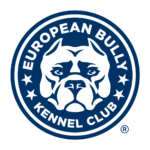BRIEF HISTORY
The Olde English Bulldogge was an attempt to recreate the “Regency Period Bull Baiter” and was developed in the early 1970s by David Leavitt, of Coatesville, PA. Mr. Leavitt began his project in 1971 utilizing the cattle line breeding scheme of Dr. Fechimer from Ohio State University.The goal was to create a dog with the look, health, and athleticism of the original bull-baiting dogs, but with a much less aggressive temperament. The foundation crosses consisted of ½ English Bulldog, and the other half Bullmastiff, American Pit Bull Terrier, and American Bulldog. After many planned crosses, the Olde English Bulldogge emerged and began to breed true.
GENERAL APPEARANCE
The Olde English Bulldogge is a muscular, medium sized dog of great strength, and possessed of fluid, agile movement. He is well balanced and proportioned, while appearing capable of performing without any breathing restrictions in either heat or in cold. Serious Faults: Excessive wrinkle, lack of pigment around eyes, nose or mouth.
The skull is large and well-proportioned to the dog’s muscular body and prominent shoulders. There is a defined furrow between the eyes (from the stop to the occiput). Narrow skull and domed forehead are faults. The muzzle is square, wide and deep. Bite is undershot or reverse scissors. Lower jawbone is moderately curved from front to back. Nostrils are wide, with a line running vertically between nostrils from the tip of nose down to the bottom of the upper lip. Nose is large and broad in relationship to the width of the muzzle. Nose color is black. Eyes are medium in size and almond shaped, dark to light brown, with black pigmented eye rims. They are set wide and low, level with the top of the muzzle. Ears are small, rose, button or tulip. Rose is preferred. They are set high, wide and to the back outer edge of the skull. The neck is medium length, wide, and slightly arched. The body is sturdy, powerful and slightly rectangular when viewed from the side. Chest is wide and deep. Hind legs are well muscled and have the appearance of being slightly longer than the forelegs. The hind legs should be straight, parallel and set apart. Accepted color patterns include brindle, and solid colors, with or without white. Dogs should be 60 to 80 pounds, and 17 to 20 inches at the withers, while bitches should be 50 to 70 pounds, and 16 to 19 inches at the withers
TEMPERAMENT AND CHARACTER
The Olde English Bulldogge is a “thinking” breed. Their intelligence is readily demonstrated by their problem solving ability and their adaptability. They are extremely sensitive dogs who bond closely with their owners and family. The Olde English Bulldogge is generally kind and peaceful with its family and friends, often extending the family circle to include other household pets as well as people. Many of these dogs have been raised with cats and it is not unusual to see them playing together around the house or in the yard, or to see cats in the kennel. Olde English Bulldogges can be territorial and should be introduced to other dogs with care. Again, many of these dogs have been raised with other dogs and carefully supervised. There is a certain degree of same-sex aggression, but training and careful supervision may help to overcome this behavior. Neutering of non- breeding animals is highly recommended after the dogs first year. In most cases, it will reduce tensions and aggression. In general, Olde English Bulldogges are highly social animals who enjoy good company in any form.
The Olde English Bulldogge is generally very accepting of strangers. In fact, they can be very outgoing and friendly. However, their friendliness is the result of their profound intelligence and their absolute confidence. In other words, while they might appear gentle and friendly, they are not indiscriminately submissive. Olde English Bulldogges are, above all, “thinking dogs” that can and will form their own perspectives of people, their environment, and situations.
Although the Olde English Bulldogge is instinctively protective, some dogs mature slowly and may not exhibit this trait until around 1 ½ to 2 years of age. The OEB is very receptive to many types of training, provided the individual Bulldogge selected for such work is outgoing, stable, confident, and the training methods employed are positive. A Bulldogge lacking confidence or harshly trained will not be reliable under pressure or capable of good judgment in all situations.
Olde English Bulldogges are generally very willing to please their owners and learn readily as a result. They can however, be stubborn about simple things like going into their kennel for the day when they would prefer to be taken along in the car. They are, after all, “thinking dogs” and they sometimes exercise this intelligence at inconvenient times. Their intelligence, sensitivity, and desire to please, combine to make them very trainable dogs. But all training should be undertaken from a positive and motivational perspective. The Olde English Bulldogge does not respond well to harsh correction or compulsion and such measures will not bring about reliable results.
The bull breeds are generally excellent with children and the OEB is no exception. They are often at their very best with children, as their intelligence, sensitivity, desire to please, and astonishing capacity for play make them excellent companions for children. Their natural protectiveness is also an asset for a family pet. As with ANY dog, young children should be supervised when playing with an Olde English Bulldogge, while the dogs are acutely aware of their size and strength, these powerful animals can easily frighten a small child if the game gets too lively. Most often, the dogs demonstrate a natural ability to adapt their games to the child’s size and strength. Fetching games and play involving simple obedience commands given by the child are excellent ways to build a rapport between child and dog.
